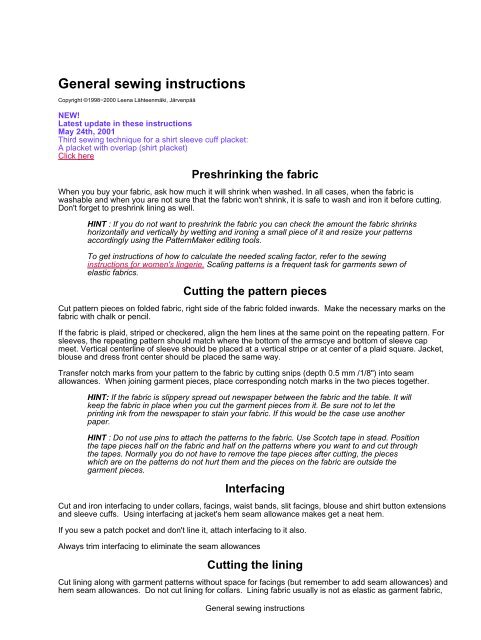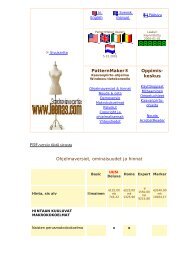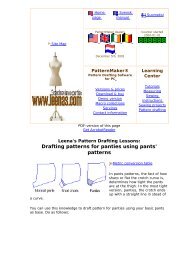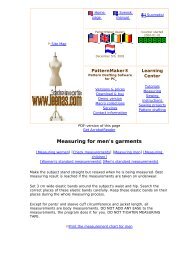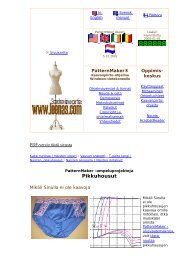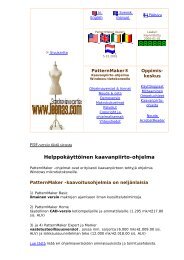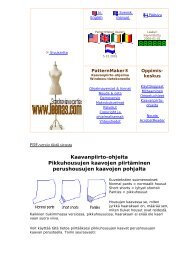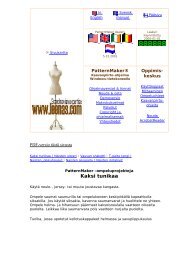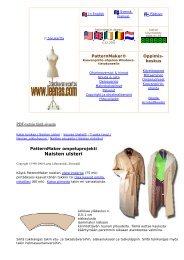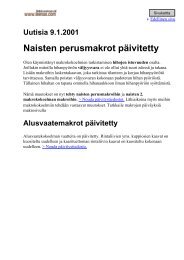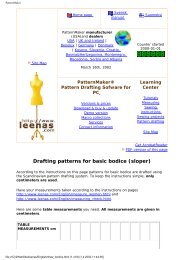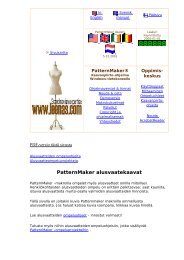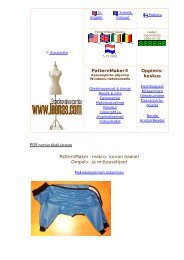General Sewing Instructions - Leena's.com
General Sewing Instructions - Leena's.com
General Sewing Instructions - Leena's.com
Create successful ePaper yourself
Turn your PDF publications into a flip-book with our unique Google optimized e-Paper software.
<strong>General</strong> sewing instructions<br />
Copyright ©1998−2000 Leena Lähteenmäki, Järvenpää<br />
NEW!<br />
Latest update in these instructions<br />
May 24th, 2001<br />
Third sewing technique for a shirt sleeve cuff placket:<br />
A placket with overlap (shirt placket)<br />
Click here<br />
Preshrinking the fabric<br />
When you buy your fabric, ask how much it will shrink when washed. In all cases, when the fabric is<br />
washable and when you are not sure that the fabric won't shrink, it is safe to wash and iron it before cutting.<br />
Don't forget to preshrink lining as well.<br />
HINT : If you do not want to preshrink the fabric you can check the amount the fabric shrinks<br />
horizontally and vertically by wetting and ironing a small piece of it and resize your patterns<br />
accordingly using the PatternMaker editing tools.<br />
To get instructions of how to calculate the needed scaling factor, refer to the sewing<br />
instructions for women's lingerie. Scaling patterns is a frequent task for garments sewn of<br />
elastic fabrics.<br />
Cutting the pattern pieces<br />
Cut pattern pieces on folded fabric, right side of the fabric folded inwards. Make the necessary marks on the<br />
fabric with chalk or pencil.<br />
If the fabric is plaid, striped or checkered, align the hem lines at the same point on the repeating pattern. For<br />
sleeves, the repeating pattern should match where the bottom of the armscye and bottom of sleeve cap<br />
meet. Vertical centerline of sleeve should be placed at a vertical stripe or at center of a plaid square. Jacket,<br />
blouse and dress front center should be placed the same way.<br />
Transfer notch marks from your pattern to the fabric by cutting snips (depth 0.5 mm /1/8") into seam<br />
allowances. When joining garment pieces, place corresponding notch marks in the two pieces together.<br />
HINT: If the fabric is slippery spread out newspaper between the fabric and the table. It will<br />
keep the fabric in place when you cut the garment pieces from it. Be sure not to let the<br />
printing ink from the newspaper to stain your fabric. If this would be the case use another<br />
paper.<br />
HINT : Do not use pins to attach the patterns to the fabric. Use Scotch tape in stead. Position<br />
the tape pieces half on the fabric and half on the patterns where you want to and cut through<br />
the tapes. Normally you do not have to remove the tape pieces after cutting, the pieces<br />
which are on the patterns do not hurt them and the pieces on the fabric are outside the<br />
garment pieces.<br />
Interfacing<br />
Cut and iron interfacing to under collars, facings, waist bands, slit facings, blouse and shirt button extensions<br />
and sleeve cuffs. Using interfacing at jacket's hem seam allowance makes get a neat hem.<br />
If you sew a patch pocket and don't line it, attach interfacing to it also.<br />
Always trim interfacing to eliminate the seam allowances<br />
Cutting the lining<br />
Cut lining along with garment patterns without space for facings (but remember to add seam allowances) and<br />
hem seam allowances. Do not cut lining for collars. Lining fabric usually is not as elastic as garment fabric,<br />
<strong>General</strong> sewing instructions


